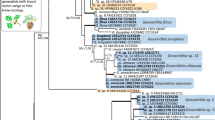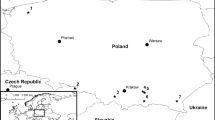Abstract
Ophiostomatoid fungi on trees are typically bark beetle associates that cause sapstain in timber and some are pathogens. Very little is known regarding the ophiostomatoid fungi associated with bark beetles in China and the aim of this study was to identify a collection of these fungi with synnematous anamorphs. Micromorphology and DNA sequences of the internal transcribed spacer regions (ITS) of the ribosomal DNA and the partial β-tubulin gene were used for identifications. The isolates could be divided in six morphological groups. DNA sequence comparisons with published data confirmed that these groups represented six species, four in the Ophiostomatales (Sordariomycetidae) and two in the Microascales (Hypocreomycetidae). The majority of these were isolated from conifer hosts. Ophiostoma quercus, O. setosum, Pesotum fragrans (Ophiostomatales) and Graphium pseudormiticum (Microascales) were found on Tsuga dumosa infested by a Pissodes sp. In addition, O. quercus and P. fragrans were found associated with Tomicus yunnanensis on Pinus yunnanensis, P. fragrans with a Pissodes sp. on P. armandi, and O. piceae with Ips subelongatus on Larix olgensis. Only two species, O. quercus and a new species in the Graphium penicilliodes complex, described here as Graphium carbonarium sp. nov., were isolated from Pissodes galleries on Salix babylonica. These results include several new fungus-host and fungus-insect associations, and G. pseudormiticum is reported here for the first time from China.





Similar content being viewed by others
References
Butterworth J, Lei Z (2005) China, peoples republic of solid wood products. China’s sixth forest resource inventory report 2005. USDA Foreign Agricultural Service, Global Agriculture Information Network, Report Number CH5027
Carlier F, Decock C, Jacobs K, Maraite H (2006) Ophiostoma arduennense sp. nov. (Ophiostomatales, Ascomycota) from Fagus sylvatica in southern Belgium. Mycol Res 110:801–810
Chung W, Kim J, Yamaoka Y, Uzunovic A, Masuya H, Breuil C (2006) Ophiostoma breviusculum sp. nov. (Ophiostomatales, Ascomycota) is a new species in the Ophiostoma piceae-complex associated with bark beetles infesting larch in Japan. Mycologia 98:801–814
De Beer ZW, Wingfield BD, Wingfield MJ (2003) The Ophiostoma piceae-complex in the Southern Hemisphere: a phylogenetic study. Mycol Res 107:469–476
Deepali K, Sigler L, Gibas CFC, Subhash M, Schuh A, Medeiros BC, Peckham K, Natul H (2007) Graphium basitruncatum fungemia in a patient with acute leukemia. J Clin Microbiol 45:1644–1647
Gams W, Hoekstra ES, Aproot A (1998) CBS course of mycology, 4th edn. CBS, Baarn
Geldenhuis MM, Roux J, Montenegro F, De Beer ZW, Wingfield MJ, Wingfield BD (2004) Identification and pathogenicity of Graphium and Pesotum species from machete wounds on Schizolobium parahybum in Ecuador. Fungal Divers 15:137–151
Georgevitch P (1927) Ceratostomella quercus n. sp. Ein Parasit der slawonischen Eichen. Biol Gen 3:245–252
Glass NL, Donaldson GC (1995) Development of primer sets designed for use with the PCR to amplify conserved genes from filamentous ascomycetes. Appl Environ Microbiol 61:1323–1330
Grobbelaar J, Aghayeva D, De Beer ZW, Bloomer P, Wingfield M, Wingfield B (2009) Delimitation of Ophiostoma quercus and its synonyms using multiple gene phylogenies. Mycological Progress 8:221–236
Halmschlager E, Messner R, Kowalski T, Prillinger H (1994) Differentiation of Ophiostoma piceae and O. quercus by morphology and RAPD analysis. Syst Appl Microbiol 17:554–562
Harrington TC, McNew D, Steimel J (2001) Phylogeny and taxonomy of the Ophiostoma piceae-complex and the Dutch elm disease fungi. Mycologia 93:111–136
Jacobs K, Seifert KA (2004) Pesotum fragrans. Can J Plant Pathol 26:79–80
Jacobs K, Kirisits T, Wingfield MJ (2003a) Taxonomic re-evaluation of three related species of Graphium, based on morphology, ecology and phylogeny. Mycologia 95:714–727
Jacobs K, Seifert KA, Harrison KJ, Kirisits T (2003b) Identity and phylogenetic relationships of ophiostomatoid fungi associated with invasive and native Tetropium species (Coleoptera: Cerambycidae) in Atlantic Canada. Can J Bot 81:316–329
Jacobs K, Bergdahl DR, Wingfield MJ, Halik S, Seifert KA, Bright DE, Wingfield BD (2004) Leptographium wingfieldii introduced into North America and found associated with exotic Tomicus piniperda and native bark beetles. Mycol Res 108:411–418
Kamgan Nkuekam G, Jacobs K, De Beer ZW, Wingfield MJ, Roux J (2008) Pesotum australi sp. nov. and Ophiostoma quercus associated with Acacia mearnsii trees in Australia and Uganda, respectively. Australas Plant Pathol 37:406–416
Katoh K, Misawa K, Kuma K, Miyata T (2002) MAFFT: a novel method for rapid multiple sequence alignment based on fast Fourier transform. Nucleic Acid Res 30:3059–3066
Kim GH, Kim JJ, Breuil C (2007) Sap-staining fungi from logs and boards of two commercially important pines in Korea. Holzforschung 61:333–336
Kirschner R (1998) Diversität mit Borkenkäfern assoziierter filamentöser Mikropilze [Ph.D. Dissertation]. Eberhard-Karls-Universität, Tübingen
Lin TC, Huang JW, Hsieh WH (2003) Identification of Ophiostomatoid fungi associated with Chinese fir wilt in Taiwan. J Plant Pathol 12:33–42
Linnakoski R, De Beer ZW, Rousi M, Niemelä P, Pappinen A, Wingfeld MJ (2008) Fungi including Ophiostoma karelicum sp. nov., associated with Scolytus ratzeburgi infesting birch in Finland and Russia. Mycol Res 112:1475–1488
Linnakoski R, De Beer ZW, Rousi M, Solheim H, Wingfield MJ (2009) Ophiostoma denticiliatum sp. nov. and other Ophiostoma species associated with the birch bark beetle in southern Norway. Persoonia 23:9–15
Lu Q, Decock C, Zhang XY, Maraite H (2008) Leptographium sinoprocerum sp. nov., an undescribed species associated with Pinus tubliformis-Dendroctonus valens in northern China. Mycologia 100:275–290
Lu M, Zhou XD, De Beer ZW, Wingfield MJ, Sun JH (2009a) Ophiostomatoid fungi associated with the invasive pine-infesting bark beetle, Dendroctonus valens, in China. Fungal Divers 38:133–145
Lu Q, Decock C, Zhang X, Maraite H (2009b) Ophiostomatoid fungi (Ascomycota) associated with Pinus tabuliformis infested by Dendroctonus valens (Coleoptera) in northern China and an assessment of their pathogenicity on mature trees. Antonie Van Leeuwenhoek 96:275–293
Luque J, Parladé J, Pera J (2000) Pathogenicity of fungi isolated from Quercus suber in Catalonia (NE Spain). Forest Pathol 30:247–263
Mathiesen-Käärik A (1954) Eine Übersicht über die gewöhnlichsten mit Borkenkäfern assoziierten Bläuepilze in Schweden und einige für Schweden neue Bläuepilze. Medd Statens Skogsforskinst 43:1–74
Matsushima T (1971) Microfungi of the Solomon Islands and Papua-New Guinea. Published by the author, Kobe
Morelet M (1992) Ophiostoma querci sur chêne en France. Ann Soc Sci Nat Archeol Toulon Var 44:109–112
Mouton M, Wingfield MJ, Van Wyk PW, Van Wyk PWJ (1994) Graphium pseudormiticum sp. nov.: a new hyphomycete with unusual conidiogenesis. Mycol Res 98:1272–1276
Münch E (1907) Die Blaufäule des Nadelholzes. I–II. Naturwiss Z Forst-Landwirtsch 5:531–573
Nevill RJ, Alexander SA (1992) Pathogenicity of three fungal associates of Hylobius pales and Pissodes nemorensis (Coleoptera: Curculionidae) to eastern white pine. Can J For Res 22:1438–1440
Ohtaka N, Masuya H, Yamaoka Y, Kaneko S (2006) Two new Ophiostoma species lacking conidial states isolated from bark beetle and bark beetle-infested Abies species in Japan. Can J Bot 84:282–293
Okada G, Seifert KA, Takematsu A, Yamaoka Y, Miyazaki S, Tubaki K (1998) A molecular phylogenetic reappraisal of the Graphium complex based on 18 S rDNA sequences. Can J Bot 76:1495–1506
Okada G, Jacobs K, Kirisits T, Louis-Seize GW, Seifert KA, Sugita T, Takematsu A, Wingfield MJ (2000) Epitypification of Graphium penicillioides Corda, with comments on the phylogeny and taxonomy of Graphium-like synnematous fungi. Stud Mycol 45:169–188
Posada D, Crandall KA (1998) MODELTEST: testing the model of DNA substitution. Bioinformatics 14:817–818
Rayner R (1970) A mycological colour chart. Commonwealth Mycological Institute and British Mycological Society, Kew
Romón P, Zhou XD, Iturrondobeitia JC, Wingfield MJ, Goldarazena A (2007) Ophiostoma species (Ascomycetes: Ophiostomatales) associated with bark beetles (Coleoptera: Scolytinae) colonizing Pinus radiata in northern Spain. Can J Microbiol 53:756–767
Ronquist F, Huelsenbeck JP (2003) MRBAYES 3: Bayesian inference under mixed models. Bioinformatics 19:1572–1574
Seifert KA (1993) Sapstain of commercial lumber by species of Ophiostoma and Ceratocystis. In: Wingfield MJ, Seifert KA, Webber JF (eds) Ceratocystis and ophiostoma. Taxonomy, ecology and pathogenicity. APS, St. Paul, pp 141–151
Stauffer C, Kirisits T, Nussbaumer C, Pavlin R, Wingfield MJ (2001) Phylogenetic relationships between the European and Asian eight spined larch bark beetle populations (Coleoptera, Scolytidae) inferred from DNA sequences and fungal associates. Eur J Entomol 98:99–105
Tamura K, Dudley J, Nei M, Kumar S (2007) MEGA4: Molecular Evolutionary Genetics Analysis (MEGA) software version 4.0. Mol Biol Evol 24:1596–1599
Thwaites JM, Farrell RL, Hata K, Carter P, Lausberg M (2004) Sapstain fungi on Pinus radiata logs—from New Zealand Forest to export in Japan. J Wood Sci 50:459–465
Upadhyay HP (1981) A monograph of Ceratocystis and Ceratocystiopsis. The University of Georgia Press, Athens
Uzunovic A, Seifert KA, Kim SH, Breuil C (2000) Ophiostoma setosum, a common sapwood staining fungus from western North America, a new species of the Ophiostoma piceae complex. Mycol Res 104:486–494
White TJ, Bruns T, Lee S, Taylor J (1990) Amplification and direct sequencing of fungal ribosomal RNA genes for phylogenetics. In: Innis MA, Gelfand DH, Sninsky JJ, White TJ (eds) PCR protocols: genes for phylogenetics. Academic, San Diego, pp 315–322
Wood SL, Bright DE (1992) A catalog of Scolytidae and Platypodidae (Coleoptera), Part 2: Taxonomic index. Great Basin Naturalist Memoirs A 13:1–6
Yamaoka Y, Wingfield MJ, Takahashi I, Solheim H (1997) Ophiostomatoid fungi associated with the spruce bark beetle Ips typographus f. japonicus in Japan. Mycol Res 101:1215–1227
Yamaoka Y, Wingfield MJ, Oshawa M, Kuroda Y (1998) Ophiostomatoid fungi associated with Ips cembrae in Japan and pathogenicity to Japanese larch. Mycoscience 39:367–378
Yamaoka Y, Masuya H, Ohtaka N, Goto H, Kaneko S, Kuroda Y (2004) Ophiostoma species associated with bark beetles infesting three Abies species in Nikko, Japan. J For Res 9:67–74
Yamaoka Y, Masuya H, Chung W-H, Goto H, To-Anun C, Tokumasu S, Zhou X, Wingfield M (2008) The teleomorph of Leptographium yunnanense, discovered in crosses among isolates from Thailand, China, and Japan. Mycoscience 49:233–240
Yan Z, Sun J, Don O, Zhang Z (2005) The red turpentine beetle, Dendroctonus valens LeConte (Scolytidae): an exotic invasive pest of pine in China. Biodivers Conserv 14:1735–1760
Ye H (1991) On the bionomy of Tomicus piniperda (L.) (Col. Scolytidae) in the Kunming region of China. J Appl Entomol 112:366–369
Yin HF, Huang SH, Li ZH (1984) Economic insect fauna of China, Coleoptera, Scolytidae. Science, Beijing
Zhou XD, De Beer ZW, Ahumada R, Wingfield BD, Wingfield MJ (2004) Ophiostoma and Ceratocystiopsis spp. associated with two pine-infesting bark beetles in Chile. Fungal Divers 15:261–274
Zhou XD, De Beer ZW, Wingfield MJ (2006) DNA sequence comparisons of Ophiostoma spp., including Ophiostoma aurorae sp. nov., associated with pine bark beetles in South Africa. Stud Mycol 55:269–277
Zipfel RD, De Beer ZW, Jacobs K, Wingfield BD, Wingfield MJ (2006) Multigene phylogenies define Ceratocystiopsis and Grosmannia distinct from Ophiostoma. Stud Mycol 55:75–97
Acknowledgements
We thank the National Research Foundation (NRF), Department of Science and Technology (DST) of South Africa, and members of the Tree Protection Co-operative program (TPCP), South Africa, and the Ministry of Science and Technology (MOST) of China for financial support (2007DFA31190). We also thank personnel from Chinese forestry bureaus in Yunnan and Jilin, and those from the Microscopy Unit at the University of Pretoria for their valuable assistance.
Author information
Authors and Affiliations
Corresponding author
Rights and permissions
About this article
Cite this article
Paciura, D., Zhou, X.D., De Beer, Z.W. et al. Characterisation of synnematous bark beetle-associated fungi from China, including Graphium carbonarium sp. nov.. Fungal Diversity 40, 75–88 (2010). https://doi.org/10.1007/s13225-009-0004-x
Received:
Accepted:
Published:
Issue Date:
DOI: https://doi.org/10.1007/s13225-009-0004-x




